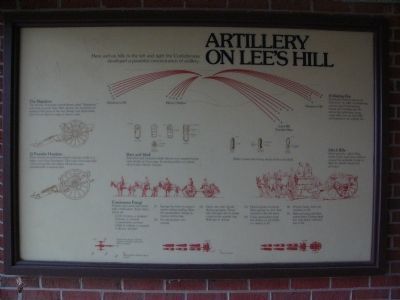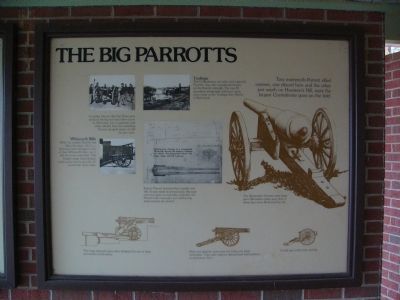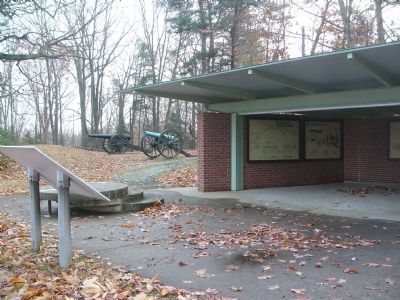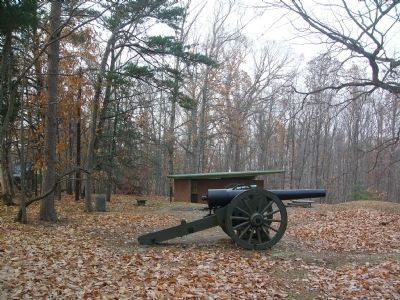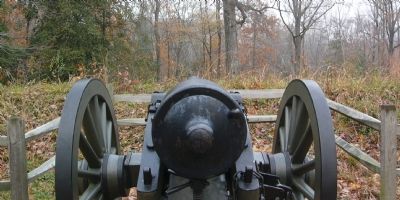Fredericksburg, Virginia — The American South (Mid-Atlantic)
Artillery on Lee's Hill
Here and on hills to the left and right the Confederates developed a powerful concentration of artillery.
Enfilading Fire
During the Federal attacks of December 13, 1862, Confederates cannon poured devasting frontal and crossfire into the advancing battle lines. Long range rifles here on Lee’s Hill participated in the enfilade fire.
The Napoleon
The bronze 12-pounder smoothbores called "Napoleons" were less accurate than rifled cannon, but remained the standard field piece of the war. Sturdy and dependable, they had an effective range of about a mile.
12-Pounder Howitzer
These bronze smoothbores lobbed explosive shells in a higher curve than Napoleons. This made them especially useful among hills and valleys. Howitzers were manufactured in several sizes.
Shot and Shell
Solid shot and explosive shells thrown into massed troops were deadly at long range. Scattering pellets of canister often broke infantry charges.
Rifled cannon fired many kinds of shot and shell.
3-Inch Rifle
Spiral grooves, called rifling, inside these small iron cannons caused the projectile to spin in flight for greater speed and accuracy.
(Right marker): The Big Parrots
Two mammoth Parrott rifled cannon, one placed here and the other south on Howison’s Hill, were the largest Confederate guns on the field.
The 30-pounder Parrotts were siege guns. Burnside’s delay gave time to bring them from Richmond by rail.
The caption of the picture on the far left of this marker identifies that one of the Confederate Parrots exploded and was replaced. Its caption reads,"A smaller Parrott, like this Union gun, replaced the big one which blew up on its 39th firing. Lee, Longstreet and other officers near the exploding Parrott escaped injury; so did the gun crew."
The adjacent picture, entitled Tredegar is captioned, "The Confederates not only used captured Parrotts, they also manufactured guns on the Parrott principle. The two 30–pounders temporarily with Lee’s army were made at the Tredegar Iron Works in Richmond."
On the far left of this marker is a picture of a, Whitworth Rifle. "While the smaller Parrott was filling the place, the Confederates were bringing in one of their Whitworth rifles, but it did not arrive until dark. This English made breechloader could easily hurl its peculiar 12-pound bolt three miles."
Topics. This historical marker is listed in these topic lists: Military • War, US Civil. A significant historical date for this entry is December 13, 1862.
Location. 38° 17.094′ N, 77° 28.575′ W. Marker is in Fredericksburg, Virginia. Marker can be reached from Lee Drive, on the right when traveling west. Markers are at the top of Lee's Hill, accessible from a parking pullout on Lee Drive. This marker is located in an exhibit shelter, along with other markers. Touch for map. Marker is in this post office area: Fredericksburg VA 22401, United States of America. Touch for directions.
Other nearby markers. At least 8 other markers are within walking distance of this marker. Lee's Hill, the commander's lookout (here, next to this marker); The Pioneers (here, next to this marker); The Second Battle of Fredericksburg (here, next to this marker); The Battle of Fredericksburg from Lee's Hill, December, 1862 (here, next to this marker); Lee's Command Post (a few steps from this marker); Near Disaster (a few steps from this marker); a different marker also named Lee’s Hill (a few steps from this marker); Lee's Headquarters (about 400 feet away, measured in a direct line). Touch for a list and map of all markers in Fredericksburg.
More about this marker. On the bottom of the left marker is a brief "how to" lesson in cannon preparation and firing. The accompanying text follows:
Commence Firing!
Sixteen men went into battle with a field piece. Each had a job to do.
Chief of piece, a sergeant
Gunner, a corporal
7 cannoneers, privates
Chief of caisson, a corporal
6 drivers, privates.
(1) Sponge the bore to quench sparks before loading. Ram the ammunition charge to bottom of the hole.
(2) Put ammunition into muzzle.
(3) Close vent with thumb during sponging. Thrust wire through vent to break a hole in the powder bag. Shift gun in aiming.
(4) Hook lanyard to primer. Place primer in vent. Jerk lanyard to fire the piece.
(5) Carry ammunition from the chests on the limber or caisson to #2.
(6) Prepare fuses. Issue ammunition to #5.
(7) Help set fuses and issue ammunition. During rapid fire, help deliver
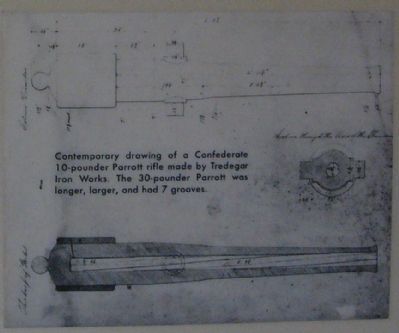
Photographed By Kevin W., December 9, 2007
4. Contemporary drawing of a Confederate 10-pounder Parrott rifle made by Tredegar Iron Works.
The 30-pounder Parrott was longer, larger and had 7 grooves.
Robert Parrott invented this capable iron rifle. It was made in several sizes. Because cast iron guns occasionally exploded, the Parrott had a wrought iron reinforcing band around the breech.
Robert Parrott invented this capable iron rifle. It was made in several sizes. Because cast iron guns occasionally exploded, the Parrott had a wrought iron reinforcing band around the breech.
Related marker. Click here for another marker that is related to this marker. Text on the right marker refers to a Parrott rifle placed "south on Howison's Hill." This related marker includes information and text on that Parrott.

Photographed By Kevin W., December 9, 2007
5. Comparison of Artillery Pieces
At the bottom of the right marker are drawings of different sized artillery pieces used by both sides during the Civil War. Captions beneath each drawing identify the type and advantage (or disadvantage) to their use:
— The huge seacoast guns were designed for use in large permanent fortifications.
— Siege and garrison guns were too heavy for rapid movement. They were used to defend fixed field positions or permanent forts.
— A field gun could move quickly.
— The huge seacoast guns were designed for use in large permanent fortifications.
— Siege and garrison guns were too heavy for rapid movement. They were used to defend fixed field positions or permanent forts.
— A field gun could move quickly.
Credits. This page was last revised on February 2, 2023. It was originally submitted on December 13, 2007, by Kevin W. of Stafford, Virginia. This page has been viewed 2,669 times since then and 35 times this year. Photos: 1. submitted on December 13, 2007, by Kevin W. of Stafford, Virginia. 2. submitted on December 14, 2007, by Kevin W. of Stafford, Virginia. 3. submitted on December 13, 2007, by Kevin W. of Stafford, Virginia. 4, 5, 6, 7. submitted on December 14, 2007, by Kevin W. of Stafford, Virginia.
